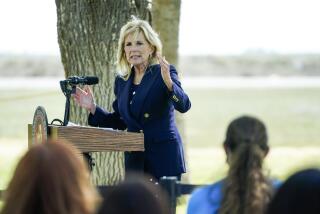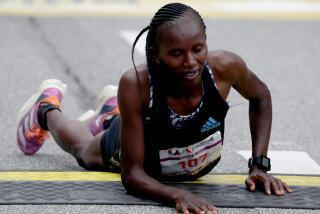Cancer Run Stirs Emotion in Big Crowd
- Share via
NEWPORT BEACH — Hundreds of pink-capped women flooded Fashion Island on Sunday for the Susan G. Komen Breast Cancer Foundation’s annual charity run and walk. But many treated the Newport Beach event more like a family reunion than a sports competition.
Take three women from the Garden Grove Unified School District who brought 426 male and female co-workers to participate, including breast cancer survivors, victims of other cancers and relatives of cancer patients.
“The whole Garden Grove school district really feels like a family because many of us have been affected. It’s heartwarming. We’ve cooked for each other. We’ve cried together. We know,” said Margaret Ferguson, 57, of Anaheim, a school principal celebrating her 20th cancer-free year.
The Garden Grove contingent was a microcosm of the participants and their supporters, many of whom were taken on an emotional roller coaster by the event in which symbolic pink caps were given to cancer survivors. There were women bald from chemotherapy cheering for their lives.
Veteran survivors realized just how many others have been through the same scary diagnosis. Sons and daughters remembered others who didn’t make it with pink signs on their backs: “In memory of my mom.”
A record number of women and men--26,000--participated in Sunday’s Race for the Cure, an annual 5K run and walk that began in Orange County in 1992. Traditionally, the Orange County event is among the 10 largest of 98 conducted nationwide each year by the Susan G. Komen Foundation. Organizers believe that the total net earnings from Sunday’s race will be $1.2 million, topping last year’s record $1 million.
Cathy Wills, president of the foundation’s Orange County affiliate, said organizers sought to increase pledges, not participants, this year. But the surge of people at the event “shows how everyone is affected in one way or another.”
Not long ago cancer victims were discouraged from speaking about their illness in public. But Sunday’s event signaled just how mainstream the once-silent disease has become. Corporate sponsors showed up with samples of food and sweepstake entries. Clinics came with information about symposiums, experimental treatments and detection tips.
Jan Thielbar of Irvine-based Belle-Amie laid her company’s products on a bed of roses: dozens of fake breast prosthetics.
The sight stunned people like Eileen Jacob, 83, of Long Beach, who silently endured breast cancer treatment 51 years ago and has since suffered from the effects of radiation and a heavy prosthetic breast that wore her skin down to the bone.
“I’m amazed. Everyone talks about this nowadays. Back then, everything was hush-hush,” she said.
Linda Tenno, 45, of Costa Mesa believes that increased publicity about breast cancer saved her life. She came to the race last year not knowing that she had a cancerous lump. Tenno, principal of Garden Grove’s Riverdale Elementary School, had only insisted on a mammogram after participating in the event last year where she learned about the importance of early detection.
“I really feel like the Race for the Cure saved my life,” she said Sunday with sons Alex, 5, and Andrew, 6, at her side.
Others rejoiced because registration fees and pledges could lead to a cure for breast cancer.
The Garden Grove school district’s director of employee-employer relations, Eileen Dibb, another survivor, said, “What we are saying is, if they can put a man on the moon, they can fix this too.”
In keeping with the race’s tradition, organizers brought breast cancer survivors, including 18 Garden Grove survivors, wearing turquoise T-shirts, to a dais.
There were about 1,400 women wearing pink hats and they were saluted with red roses, songs and speeches.
Inspirational songs such as “We Are the Champions” resonated. Balloons in every color and rounds of applause added to the festivities.
But over and over, the emotions of participants ran from glory to gloom.
So many women’s lips remained curled and their throats knotted as they tried to hold back tears for numerous group photographs.
“Those are good tears, healing tears,” Ferguson said.
More to Read
Sign up for Essential California
The most important California stories and recommendations in your inbox every morning.
You may occasionally receive promotional content from the Los Angeles Times.













